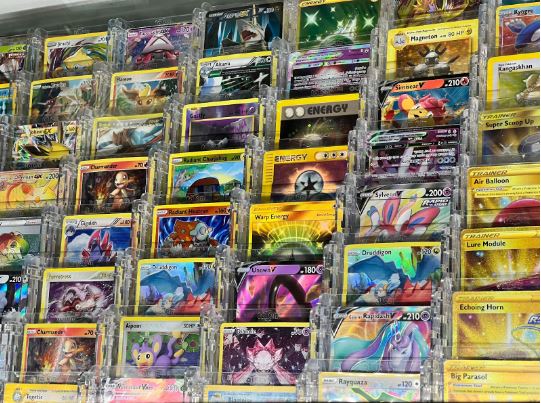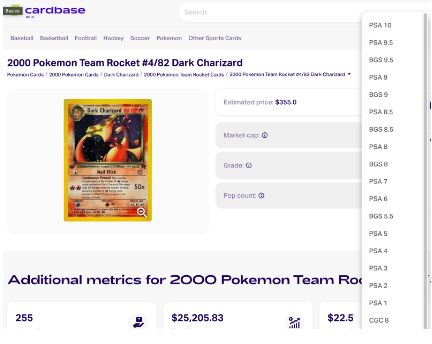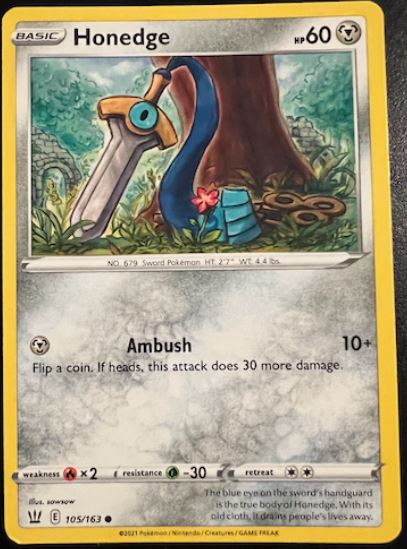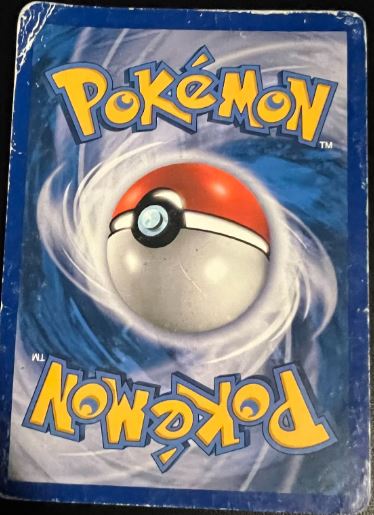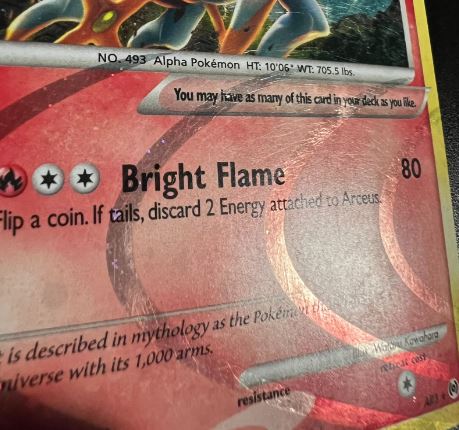Have you ever wondered how to turn your beloved stack of Pokémon cards into valuable PSA-graded treasures? How much is your Pokedex actually worth? Let’s face it: Most Pokémon cards aren’t worth anywhere near as much money unless they are graded at the top level of the grading scale.
With the cost of grading cards being a substantial investment (every card can be $15-$30 to grade), you want to make sure you’ve got a real shot at a PSA 10 Gem Mint card or it may not be worth sending your cards in for a review and rating.
In this article, we’ll delve into the world of grading Pokémon cards for PSA (Professional Sports Authenticator) so you can prepare your cards, as well as your expectations, for submitting cards in for the official grading process of one of the premium card quality grading services in the world.
While you can certainly get your cards graded at BGS, SGC, CSG, or others, PSA is the most recognized and well-regarded grading service for Pokémon cards specifically. While BGS is known for grading cards of all sports and they are the only other grading platform with PSA’s level of prestige (see our comparison here), Pokémon collectors and investors have come to rely on PSA for grading Pokémon cards specifically because of their expertise.
Why Grade Your Pokémon Cards?
If you love the Pokémon TCG, why would you put your precious cards in a slab that prevents them from being used in a future duel? Well, the main reason is to resell them for a profit, but you can also have them graded to protect them from damage if you are a collector more than a player. Collectors may also enjoy getting their cards properly graded as part of putting together a valuable collection full of top-quality cards.
Whatever your motivation, we’ll cover the way PSA reviews a card for grading so you can understand the chances that your cards will be graded in the top-tier. If you look at online pricing, it’s clear that PSA 10 Gem Mint grades will massively increase the value of most cards. Many collectors and investors won’t even submit cards they worry won’t at least have a shot at getting a Gem Mint grade because the top grade is worth so much more than the other grades.
One more point to consider is the age or era of the card. If it’s a brand-new card, there’s very little reason to get it graded unless it will likely qualify for a PSA 10 grade. That’s the only way you’ll make significant money on the card. This isn’t necessarily true for classic cards from the early days of the game. For vintage cards, a lower grade can still be quite valuable depending on the card itself. There are other factors involved with older cards, such as historic or nostalgic value that could enable them to still be worth more even if they aren’t minty-fresh. This is especially true for limited edition cards or those that could only be won at a tournament or special event that happened twenty years ago. They won’t be back so these cards will almost always be sold at a nice premium.
Before you grade your cards, you can also check them against the pricing here on Cardbase. Conveniently, there are drop-down options on the card’s page to help you find the price you can expect for each grading option. Not every possible rating is immediately available on every card. For example, if there have been no sales at that pricing, there won’t be any data about the prices. But you can usually get a good idea of what the market will pay for the card based on the references on the card’s page.
Can You Make the Grade?
The process of grading your Pokémon cards for PSA might initially appear to be an overwhelming task, but truth be told, it's an exceptionally fulfilling and rewarding process. At its core, it's about more than just appraising the value of your cards. It's about preserving those cherished treasures that hold such significant sentimental value. And of course, if fortune smiles upon you, there's also the potential of making a decent amount of Poke-dollars along the way - a delightful win-win situation. So, it's time to equip yourself with your trusty magnifying glass, and embark on this exciting journey of grading. Let's dive in, and explore the rewarding world of Pokémon card grading together!
Understanding the PSA Grading Scale
First things first, PSA grading is like the Pokémon Gym of the card world. The cards you submit will face the ultimate test to prove their value. The PSA scale runs from 1 to 10, with 10 being the mythical, unicorn-like 'Gem Mint' status. You can think of achieving that grade like catching a shiny Pokémon. They are rare and quite rewarding to get. You may still be able to sell cards with a lower rating, but the drop in value is significant.
Key Factors in Pokémon Card Grading
PSA’s website has a good breakdown of the main factors that determine the grade of a card, but here are the basics to consider.
Card Centering
Is your Pokémon sitting in the middle of the card, or does it look a bit like it wandered off to the side? While the printers surely do their best, it’s not uncommon to find cards that are simply off-center. Look at the borders on the card to see this more easily. They should be the same width, but printing errors can reduce this symmetry. Don’t forget to look at the back of the card for this issue because the PSA folks sure will. Even a centering issue on the backside of the card will cost you that PSA 10 grade.
Usually, it’s possible to eyeball significant centering issues like this one on Honedge above. But if you aren’t sure, just grab a ruler and compare it on centimeters, not inches, to allow your estimate to be more exacting.
Card Corners
Sharp and unchipped corners are the goal. If your card corners look like they've been chewed on by a wild Rattata, PSA graders will not be kind to you. Corners should be clean and untouched by play, which will almost always hit the corners first.
If your corners look like these, skip the grading process because this kind of damage will keep you from getting a high grade.
Card Edges
Watch out for whitening or fraying. Even a tiny patch of white can cost you points on the PSA grading system. Remember to inspect the whole card, including the back to make sure you aren’t seeing more damage on the reverse of the card. Ideally, you want edges smoother than Voltorb’s head
The edges above show whitening all around but even small patches of whitening can cost you points on the grading scale.
Card Surface
Scratches, scuffs, or fingerprints will not help you on your path to Gem Mint status. No stains, discoloration or faded of the gloss on the card will do if you want to impress PSA graders. See below for more examples of damage that will rule out a good score based on the surface damage to the card.
Does your card look good by all of these criteria? If so, it might be worth getting it graded in hopes of achieving a PSA 10. Carefully assess your card against these standards and don’t be too easy on them! It's worth grading if it either meets the high standards set by PSA for a gem mint or has a reasonable chance of doing so.
Step-by-Step Grading Guide for Pokémon Cards
- Light and Magnification: Ensure to use optimal lighting and a magnifying glass for inspection. Consider yourself a detective, looking for signs of wear and tear.
- Handling: Always handle the cards in sleeves to prevent damage. The oils on your fingers can be more damaging to cards than Team Rocket.
- Inspection: Begin with the front side. Examine the artwork first, then proceed to the borders. Carefully flip the card over and repeat. Think of it as grooming your Eevee—gentle yet thorough.
- Flaws: If you spot a flaw, don't lose heart - be honest with yourself about the condition. Not every card can achieve a PSA 10 grade, just like not every Pokémon can be a Charizard. If you are firm about flaws, you won’t waste money grading cards that won’t benefit from PSA’s seal of approval.
- Comparison: Compare your card with PSA-graded cards for reference. This way, you can see directly what a PSA 10 or another grading level will look like.
If you don’t have any PSA-graded cards, check out your local card store that is sure to have some for sale. Ask to examine them because even through the slab, you can see the quality of the cards. Store attendants can also be good sources for information about grading.
The PSA Grading Scale in a Nutshell (Poke Ball?)
1- Poor: This is the lowest grade. These cards show severe wear and tear. The card might be missing some elements, like a cardback coming off. Water damage is also a factor that will stick a card with a Poor rating. Think of the original 1999 Base Set cards that people have been dueling with for the last 24 years.
1.5 - Fair: A Fair card will show extreme wear, including scuffs, scratches, pits, chips, and stains. The image may be misaligned and borders dirty. Despite heavy wear, to qualify as Fair, the card must be intact without any missing pieces or major damage like back layer removal or a missing corner. Not much to ask for, but have you seen some cards that have been played a lot?
At other levels, cards may get half-point rating upgrades and downgrades if the card is really on the edge of the higher or lower score. This can change pricing on cards a bit, but not too much.
2- Good: This grade’s name sounds a lot better than the previous one, but it’s still a pretty low grade. These cards will show moderate wear but are still in one piece and won’t be so flawed that you can’t make out whether there’s a Bulbasaur or a Psyduck on them.
3- Very Good: Okay, these cards are in decent condition, but this is really only a positive thing if you’re talking about vintage cards. No modern cards should be graded if they have visible wear on them, which would stick them with a rating like this one.
4- Very-Good-Excellent: At this level, the card can have minor wear, but they shouldn’t be too beat up. Notable whitening and edge issues are common issues that will push a card down to this level. Even these still look quite sharp even if the 4 seems like a low score.
5- Excellent: While these are not gem-minty, cards with this rating can’t have more than a few minor imperfections.
6- Excellent-Mint: The word ‘mint’ entering the language is key: These cards must be closer to perfect than not. The average player will see these cards are basically perfect.
7- Near Mint: Only the tiniest of flaws can affect these cards. They’re as close to perfect as you can get and most people will see them that way.
8- Near Mint-Mint: PSA notes that, at first glance, you can’t tell a PSA 8 from a PSA 9. Only careful inspection will reveal the minor imperfections allowed at this level of grade. Perhaps they can be a miniscule printing imperfection, the smallest of fraying on a corner, or maybe borders on the back being a hair off.
9- Mint: To all but the most discerning eye, these cards are perfect. They show no signs of wear, play, or age. Their flaws are minor enough to possibly need a magnifying glass. In this range, you can often expect solid sales from collectors that want a gorgeous version of a card but can’t pay for flawless PSA 10s.
10- Gem Mint: PSA’s Gem Mint is the Holy Grail of Pokémon card grading. It's like catching a shiny Pokémon - rare, valuable, and absolutely perfect. These cards are flawless and will command impressive premiums over even cards with a PSA 9 rating.
Preserving Your Cards for Grading
Getting that PSA 10 rating on your cards is all about treating them right. These precious collectibles need TLC right as they come out of the pack. Let’s talk about how you can keep your cards in tip-top shape until they are mailed out to PSA’s offices.
Start Protecting Your Cards Immediately
When you buy cards in decks and booster packs, you need to be conscious of how they’re handled from the first moment you get them.
- Cautiously open the package so you don’t cause the cards to fall out or get scratched by your fingers pulling at the plastic. You may want to don gloves to keep the oil from your fingers off fresh cards.
- Carefully remove them from the pack without touching the edges or corners, if you can manage it. Keep plastic sleeves handy when you do this so you’re ready for the next step.
- Review the card for grading potential. Again, this is best done with gloves on so you don't get fingerprints or oils on the cards. You will need to see them clearly before you sleeve them, so be extra cautious while your cards are not yet protected.
- Immediately and with care, place your cards into sleeves. Make sure you use the right sized sleeves. If they’re too big, they can end up damaged when they bang around in such a big space. If they’re too small, you can damage the cards while trying to shove them into a sleeve that isn’t big enough.
- For cards you know are going to be valuable, consider putting them directly into top-loader cards. These cards are like suits of semi-rigid armor that will keep your card from moving around too much in transit, and they effectively protect against handling.
- Ideally, any card that you believe could get a PSA 10 rating should be sent as soon as possible. The sooner these pristine cards get into an official PSA slab, the better.
Plan for Gem Mint Grades
Grading your Pokémon cards is an exciting journey that takes time, care, and a keen eye for detail. If you follow our guide, this process can significantly enhance the chance that you will invest in grading cards that will increase the value of your collection. Whether that means selling them for a profit or just helping preserve your cherished treasures, we believe this insight will help you shoot for PSA 10s more accurately.
So, trainers, ready with your sleeves and top-loaders, plus a good magnifying glass and a readiness to judge your cards directly. May your grading adventures lead you to many 'Gem Mint' discoveries!
Are you ready to learn more about selling those PSA 10s? Don’t miss our comprehensive guide to selling and buying Pokémon cards online.
